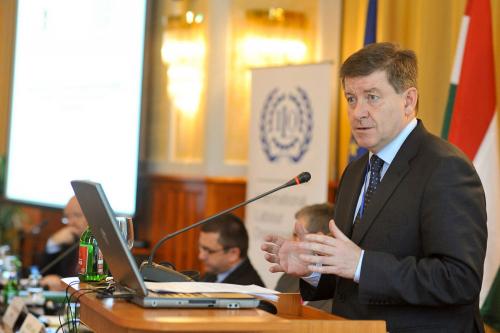World’s youth facing worsening unemployment, warns new UN report
Global unemployment rose in 2012 amid continuing economic insecurity and insufficient policies stifling overall hiring, a new report by the United Nations labour agency has warned, adding that the world’s youth were most vulnerable to the growing job scarcity.

ILO Director-General Guy Ryder speaking at the Youth Eemployment Tripartite Seminar on 11 January 2013 in Budapest, Hungary.
In its annual Global Employment Trends report, released Monday, the International Labour Organization (ILO) notes that despite the positive trend of falling unemployment over the past two years, the number of unemployed worldwide rose by 4.2 million in 2012 with gloomy expectations of a further increase in 2013.
“An uncertain economic outlook, and the inadequacy of policy to counter this, has weakened aggregate demand, holding back investment and hiring,” Guy Ryder, the ILO Director-General, announced in a news release accompanying the report.
“This has prolonged the labour market slump in many countries, lowering job creation and increasing unemployment duration even in some countries that previously had low unemployment and dynamic labour markets,” he added.
In particular, the report singles out the impact of the global unemployment crisis – already afflicting over 197 million people worldwide – on the world’s youth, who risk losing vital professional and social skills as the length of their joblessness continues to grow.
“Many of the new jobs require skills that jobseekers do not have,” Mr. Ryder confirmed.
According to the ILO, some 35 per cent of unemployed youth in advanced economies have been out of a job for six months or longer – an absence which directly impacts their long-term career prospects as their skills deteriorate. Others, meanwhile, get discouraged and leave the labour market altogether.
With almost 74 million people in the 15 to 24 age group unemployed around the world, translating into a 12.4 per cent unemployment rate for this subset, job prospects for the world’s younger workers are looking increasingly bleak, says the report.
The UN official pointed out that regional differences in youth unemployment were likely to be marked, with the situation expected to improve slightly over the next five years in the developed economies while emerging economies in Eastern Europe, East and South-East Asia and the Middle East would continue to see rising joblessness among its young labour force.
He added, however, that it was incumbent on international policy-makers to find a coordinated response to reversing the problem and urged governments to establish coordinated retraining activities to help young people bridge the skills gap caused by extended bouts of joblessness.
“The global nature of the crisis means countries cannot resolve its impact individually and with domestic measures only,” declared the ILO Director-General.
The report specifically calls on policy-makers to engage in three areas crucial to employment generation, including injections of public investment into job-creating initiatives while private funding remains shy; addressing rising labour market mismatch problems through retraining and re-skilling programmes; and focussing action on youth joblessness.
“The high uncertainty, which is holding off investments and job creation, will not recede if countries come up with conflicting solutions,” cautioned Mr. Ryder. “The costs of inactivity, of allowing long-term unemployment to grow and young people to disconnect further from society, would be far higher.”
Source: UN News
- 348 reads
Human Rights
Ringing FOWPAL’s Peace Bell for the World:Nobel Peace Prize Laureates’ Visions and Actions

Protecting the World’s Cultural Diversity for a Sustainable Future

The Peace Bell Resonates at the 27th Eurasian Economic Summit

Declaration of World Day of the Power of Hope Endorsed by People in 158 Nations

Puppet Show I International Friendship Day 2020

